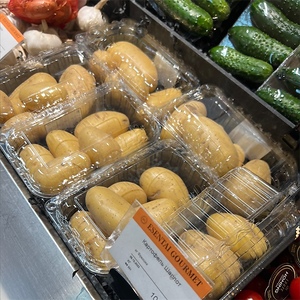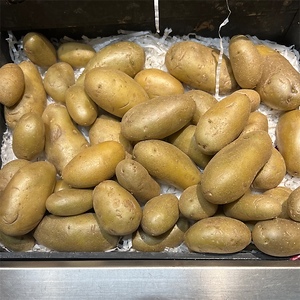


Charlotte Potatoes
Estimated Inventory, lb : 0
Description/Taste
Charlotte potatoes are a small to medium varietal, averaging 4 to 5 centimeters in diameter, and have an elongated, oval to oblong shape with slight tapering towards each end. The potato’s skin is thin, smooth, flaky, and delicate with a pale yellow to light brown hue. The surface is also covered in a small dark brown spots and a few shallow eyes. Underneath the skin, the golden yellow flesh is firm, slippery, and finely textured. Charlotte potatoes have a low dry matter content and a waxy consistency, contributing to the tuber’s dense but tender texture. The potatoes hold their shape in cooking and have a subtly sweet, nutty, and earthy flavor.
Seasons/Availability
Charlotte potatoes are available year-round, with peak seasons in the late winter through spring and late summer through early fall.
Current Facts
Charlotte potatoes, botanically classified as Solanum tuberosum, are a French variety belonging to the Solanaceae or nightshade family. The potatoes are a second early variety, also known as new potatoes, meaning that they take approximately 10 to 12 weeks to mature. Charlotte potatoes were developed in the late 20th century and achieved commercial success in Europe, especially in France, relatively quickly and are slightly larger than standard new potatoes. The tender tubers are cultivated for commercial markets and grown in home gardens, favored for their easy-to-grow nature, disease resistance, quality flavor and texture, and prolific harvest, producing approximately 24 potatoes per plant. When cooked, Charlotte potatoes retain their shape and are valued as a versatile tuber in a wide array of savory preparations.
Nutritional Value
Charlotte potatoes are an excellent source of vitamins such as vitamin C to strengthen the immune system and B vitamins to maintain overall health. The tubers are also a good source of fiber to regulate the digestive tract and minerals, including potassium to balance fluid levels within the body, magnesium to control nerve functions, phosphorus to protect bones and teeth, and lower amounts of iron, calcium, folate, and riboflavin.
Applications
Charlotte potatoes are a versatile, multi-purpose variety suited for boiling, steaming, roasting, sautéing, and baking. The potatoes are famous for their use as a salad potato, as the tubers can be boiled or steamed without losing their shape. Charlotte potatoes can be served hot or cold, and the potato’s firm texture can be combined with many different ingredients without disintegrating. The tubers can also absorb sauces and develop a tender consistency when simmered into soups, curries, and stews. In addition to boiling whole, Charlotte potatoes can be cut and incorporated into gratins and casseroles, sliced into hasselback, or roasted and served as a side dish to savory main dishes. Charlotte potatoes are often planted in the early fall and are harvested for Christmas dishes in England. They are also cooked into frittatas, shredded into hash browns, or baked whole. In France, Charlotte potatoes are served with melted cheese and are baked in a gratin with onions, bacon, cheese, cream, and wine in the well-known recipe tartiflette savoyarde. Charlotte potatoes pair well with ginger, paprika, herbs such as thyme, parsley, dill, and basil, garlic, fennel, broccoli, beets, coconut milk, meats such as poultry, chorizo, beef, sausage, and tuna, cheeses including blue, parmesan, and raclette, crème fraiche, apples, tomatoes, and pickles. Whole, unwashed Charlotte potatoes will keep 2 to 3 weeks when stored in a cool, dry, and dark location.
Ethnic/Cultural Info
Charlotte potatoes are considered one of the most cultivated firm-fleshed potatoes in France and are often mentioned by name in recipes. Breeder Roger Salaun named the variety Charlotte to appeal to the European market. Salaun wanted the potato’s name to be easily pronounced across many different languages, and he commented that the name Charlotte is often used within the lineages of royalty throughout Europe. Charlotte potatoes are also one of the famous varieties cultivated on the Ile de Ré, a small island along the Atlantic Coast of France. There are five different varieties of potatoes generally sold under the Ile de Ré name, and each variety contains subtle flavor and texture variations. The most popular types are Charlotte and alcmaria, favored for their sweet taste, and other varieties include starlette, amandine, and leontine. Ile de Ré potatoes are one of the only tubers in France to receive an Appellation d’Origine Controlee, or AOC, which is a certification that protects the geographical location, soil type, and unique cultivation techniques used on the island to produce the tubers. The tubers are culinary treasures of the island and have become an exclusive ingredient, only available locally for a very limited season.
Geography/History
Charlotte potatoes were developed in 1981 by breeder Roger Salaun in Saint-Goazec, a commune within the Finistere department of Brittany in northwestern France. The variety was created from a cross between danae and hansa potatoes and was selected for its flavor, texture, and hardy nature. Salaun was an agricultural engineer at a laboratory located within one of the buildings of the Chateau de Trevarez and had been working as an engineer there since 1954. It took ten years for Salaun to create Charlotte potatoes, and over 40,000 tubers were planted before Salaun was satisfied with the new cultivar. After their release in the late 20th century, Charlotte potatoes became a favored variety for commercial growers and home gardeners throughout Europe, eventually receiving an Award of Garden Merit by the Royal Horticultural Society in England in 2011. Today Charlotte potatoes are a common variety available through grocers, distributors, and farms throughout Europe. The cultivar is especially grown in high concentrations for markets in France and England.
Recipe Ideas
Recipes that include Charlotte Potatoes. One
| BBC Good Food |
|
Garlicky Fondant Potatoes |
















